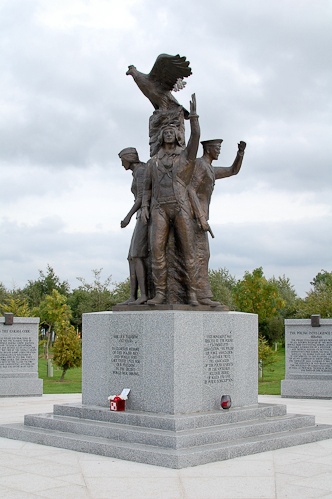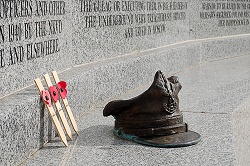Polish Armed Forces Memorial - National Memorial Arboretum
98 Books about Poland | Polish War Graves in Britain
In September 2009 the Polish Armed Forces Memorial was unveiled at the National Memorial Arboretum in Staffordshire, England. The monument commemorates the sacrifice that Polish Forces made in the 2nd World War For Your Freedom and Ours.
The memorial statue consists of sculptures of four branches of the Polish Armed Forces. They symbolise a Polish Pilot from 303 Squadron, a woman courier from the Polish underground, a Polish soldier from the battle of Monte Cassino and a sailor from the Polish destroyer Blyskawica. At the top of the statue is a Polish Eagle the symbol of the Polish State.
The Rogatywka, a Polish Army officer’s hat, has been incorporated into the Polish Armed Forces memorial as a symbol of the Polish Forces uniform in September 1939.
The Polish Armed Forces Memorial statue is surrounded by a series of plaques inset into the monument which describe the Polish contribution to the Second World War. The text on the plaques gives the main historical facts.
The Polish Armed Forces Memorial was unveiled by the Duke of Kent at a ceremony on 19 September 2009 attended by Her Excellency Barbara Tuge-Erecinska, the Polish Ambassador to Britain.
Video
Dr Marek Stella-Sawicki, Chairman of the Polish Armed Forces Memorial Project, explains what the Polish Armed Forces Memorial represents.
Plaques on Memorial
There are 16 plaques inset on the memorial which describe the Polish contribution in the 2nd World War. The text on these plaques is given below.
- The Polish Campaign 1939
- In September 1939 Poland was attacked on two fronts. German forces invaded on 1st September, extensively bombing military and civilian targets. Poland mobilised a million men, but was outnumbered by overwhelming odds. On 17th September, the Soviet Army invaded from the east. The Polish government and some military units withdrew to Romania and Hungary. The campaign lasted five weeks. Polish losses against the Germans were 68,000 killed and 140,000 wounded. Most Polish soldiers taken prisoner by the Soviets were sent to labour camps, but over 25,000 officers and other personnel were murdered in 1940 by the NKVD at Katyn, Kharkov, Midenoye and elsewhere.
- The Polish Underground State 1939-45
- After the 1939 invasion, an underground state was formed, owing allegiance to the Polish government in exile. It constituted one of the largest and best organised allied resistance movements, maintaining radio and courier contact with the government and allies, covering both German and Soviet zones of occupation. It established "Zegota" - an organisation helping Jewish citizens, particularly in the Warsaw Ghetto in 1943. Advancing Soviet Forces disarmed the resistance units in 1944, deporting many to the gulag or executing them. In 1945, 16 leaders of the underground were treacherously abducted and tried in Moscow.
- The Warsaw Uprising August-October 1944
- Following 5 years of brutal Nazi occupation, involving terror, deportations to Auschwitz and other concentration camps, on 1st August 1944 the Polish underground army in Warsaw engaged the Germans in battle, encouraged by promises of Soviet support from the approaching Red Army. However, Stalin ordered his forces to halt on the eastern bank of the river Vistula. After fighting alone and heroically for 63 days, one of the longest battles of WWII, the Warsaw uprising ended. In retaliation, Hitler ordered Warsaw to be razed to the ground. Despite Warsaw's sacrifice, Poland was not to regain her independence in 1945.
- Breaking the Enigma Code
- One of the great Polish contributions to the Allied cause was the handing over of replicas of the German Enigma coding machine, with accompanying technical descriptions, to Poland's British and French allies in July 1939. The Enigma machine was used by the German armed forces for high-level secure radio communication. Three Polish mathematicians succeeded in breaking the Engima code in the 1930s, when it was considered unbreakable. The Enigma/Ultra operation was decisive to the Allied victory in Europe in WWII and undoubtedly contributed to shortening the war and saving many lives.
- The Polish Intelligence Service 1939-45
- The Polish Intelligence Service provided 43% of all reports received by the British Secret Service from continental Europe, giving the Allies invaluable information of a strategic, operational and tactical nature. Its activities covered German-occupied Europe, neutral countries, Germany, the Middle East and North Africa. It contributed to the planning and conduct of Allied campaigns in North Africa in 1942 and the Normandy D-Day landings in 1944. It revealed the existence of Nazi death camps and the holocaust on German-occupied territory as well as providing technical details of the V1 and parts of the V2 rocket.
- The French and Norwegian Campaigns 1940
- Polish sliders who escaped from Poland regrouped in France, this Polish Army, under General Sikorksi soon numbered 84,000 ground troops and four air squadrons. The Polish Highland Rifle Brigade distinguished itself in the battle for Narvik. The 1st Grenadier division was placed on the Maginot line and fought in Alsace. The 2nd Rifle division after fierce fighting at Clos-du-Doubs (the Belfort Gap), crossed into neutral Switzerland. The 10th Armoured Cavalry Brigade fought at Montbard. Some 1,400 Polish soldiers were killed in France and 4,500 were wounded, 20,000 were evacuated to Britain.
- Polish First Corps
- Polish troops evacuated from France in 1940 were stationed in Scotland. They contributed to the defence of Great Britain against an expected German invasion from Norway. The Corps eventually formed the 1st Polish Armoured Division, the 1st Polish Parachute Brigade, the 4th Infantry Division, the 16th Armoured Brigade and various specialist training centres. From 1942 onwards, these units prepared for the liberation of Europe. In addition, various Polish auxiliary formations, such as the Staff College, the Intelligence training centre and military hospitals, were also located in Scotland.
- The Polish Carpathian Rifle Brigade
- In 1940, Polish soldiers reaching Syria, via Romania, Hungary and Turkey, formed the Carpathian Rifle Brigade. In 1941, the 5,000 strong brigade under General Kopanski joined British forces in Libya. The brigade took part in the defence of besieged Torbruk in that year. It then broke through enemy positions at Gazala. This success helped the British 8th Army to renew its offensive against Rommel's Afrika Korps and his Italian allies. The impact made by Polish soldiers during these battles earned them the right to be honoured as the "The Rats of Tobruk".
- Polish Second Corps
- After the Polish-Soviet agreement of 1941, leading to the conditional release of Polish prisoners held in the Soviet Union, a Polish Army was formed in the USSR from these prisoners. Out of over 1,500,000 deportees, only 114,000 left for Iran; 70,000 were soldiers who formed the Second Corps under General Anders - the largest Polish formation in the West. Its two divisions and armoured brigade subsequently took part in the Italian campaign, capturing Monte Cassino, opening the road to Rome and later taking Ancona and Bologna. The Polish Second Corps lost 3,978 men in the Italian campaign.
- The Polish Navy
- In 1939 three Polish destroyers, followed by two submarines, escaped from Poland across the German-controlled Baltic to join the Royal Navy. The Polish Navy expanded to 30 ships: 2 cruisers, 10 destroyers, 8 submarines and 10 torpedo boats. They took part in the Battle of Narvik, the evacuation of Dunkirk, the sinking of the Bismarck, the Battle of the Atlantic, the Dieppe raid, Operation "Torch" in North Africa and the Normandy D-Day landings. They also helped to escort convoys. 54 vessels of the Polish Merchant Navy helped to keep the Allied supply lines open - carrying nearly 5 million tons.
- The Polish Air Force (PAF)
- After the German and Soviet invasion of Poland in September 1939, the Polish Air Force was reformed in France and Great Britain. In 1940 Polish airmen participated in the defence of France. Polish fighter pilots played a vital role in the Battle of Britain, destroying 203 enemy aircraft - a confirmed 7.5% of total German losses. Later Polish bomber crews made an important contribution to the RAF bomber offensive. The PAF, expanded to 15 squadrons, distinguished itself in all major air operations against Germany. In total 1,903 Polish airmen lost their lives by May 1945 while serving under RAF command.
- The Polish 1st Armoured Division
- The 1st Armoured Division, formed in Scotland in 1942 under General Maczek, took part in the campaign in north-west Europe, playing a decisive role in closing the famous falaise gap, cutting off the retreating German army. During heavy fighting, the division liberated towns and villages in France, Belgium and Holland, including Breda. It crossed into Germany and liberated Oberlangen POW camp, which held Home Army Polish women soldiers from the Warsaw Uprising. The division went on to take the German naval base of Wilhelmshaven and was an occupying force in the British sector.
- The Polish 1st Independent Parachute Brigade
- The Polish 1st Independent Parachute Brigade was formed in Scotland in 1941, under General Sosabowski, to assist in an anticipated uprising in Poland against the Germans. Instead, the Polish Parachute Brigade was ordered to participate in operation "Market Garden" in September 1944 - a bold but ill-fated airdrop at Arnhem to help hold the bridges of Holland for an allied armoured thrust into Germany. There the brigade lost 23% of its fighting strength while covering the British withdrawal across the Rhine.
- Polish Section of S.O.E. and Poland's "Silent and Unseen"
- Although partitioned by Germany and the USSR, Poland never surrendered, Polish Forces were re-formed abroad and an underground army was organised in Poland itself. Polish officers trained and equipped in Great Britain by S.O.E. were parachuted into Poland to sabotage the enemy. The attacks on German lines of communication greatly assisted the war effort. Many of these Polish special forces were either executed immediately or arrested and never heard of again. However, some survived to continue resistance against the German and Soviet occupations.
- Polish Women in WWII
- Polish women participated in combat and auxiliary formations throughout WWII. Their role was vital to the activities of the Polish underground movement, where they took part in combat, gathered intelligence and provided communication services and medical support. During the Warsaw Uprising in 1944 17% of resistance fighters were women and over 3,000 lost their lives during that battle. On the Western and Eastern fronts, women saw service in the Army, the Navy and the Air Force. Altogether over 50,000 women took part in the resistance movement and over 5,000 served with the regular armed forces.
- The Polish Army on the Eastern Front
- In 1943 the Polish 1st Infantry Division was formed in the USSR from deportees from the labour camps, offering those Poles unable to join General Anders a way out of the USSR. Initially it consisted of somne 11,000 soldiers and grew through conscription on Polish territories occupied by the Soviets to two armies totalling 400,000 soldiers. It took part in the Battle of Lenino, the forcing of the Vistula Line, the Attack on the Pomeranian Wall, the capture of Kolobrzeg, the drive on Dresden and the Battle for Berlin, suffering heavy losses in the process.
Related Material
- The Polish Armed Forces Memorial website.
- Polish Pilots from the Battle of Britain Remembered, Stoke and Staffordshire, BBC (15 September 2010).
Added on 27 September 2010.

